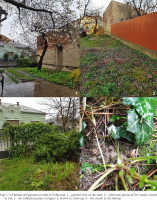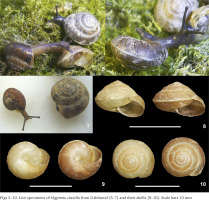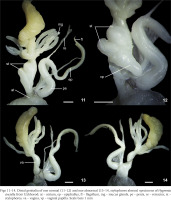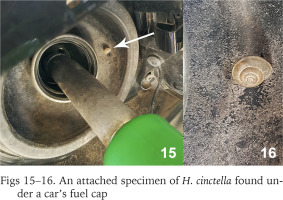In early March 2023, photographs of a medium-sized land snail shell from Uzhhorod, Transcarpathian region of Ukraine (observation 150292228 by Eva Andrik) were uploaded into the citizen science database iNaturalist (2023). Initially it was identified as Euomphalia strigella (Draparnaud, 1801), then as Monachoides vicinus (Rossmässler, 1842). A more detailed study of these images suggested that Hygromia cinctella (Draparnaud, 1801) is shown on them. H. cinctella is a Mediterranean species (Kerney et al. 1983), the present range of which has been significantly expanded due to anthropochory both in Europe (Vimpère 2006, Weddle 2009, Říhová & Juřičková 2011, Van den Neucker & Scheers 2014, Dedov et al. 2015, Möltgen-Goldmann 2015, Kwitt & Patzner 2017, etc.) and beyond (Walton 2017, Salvador et al. 2022, GBIF 2023, iNaturalist 2023).
From the countries directly bordering the Transcarpathian region of Ukraine (Romania, Hungary, Slovakia, and Poland), H. cinctella is known as an introduced species for Hungary, but usually not eastward of Budapest (Kerney et al. 1983: map 308, Vimpère 2006: fig. 1, Proćków et al. 2019: fig. 5a, GBIF 2023, iNaturalist 2023). The distribution map of this species in the monograph by Welter-Schultes (2012: 544) shows also two localities in Hungary situated further to the east. One of them is near the Ukrainian border and not far from Uzhhorod. According to Domokos (2013), the easternmost known locality of H. cinctella in Hungary is Jánkmajtis, which almost coincides with the map of Welter-Schultes (2012).
Figs 1–4
Habitat of Hygromia cinctella in Uzhhorod: 1 – general view of the yard; 2 – collection points of live snails, circled in red; 3 – far collection point in Figure 2, shown in close-up; 4 – live snails in the habitat

In Slovakia, H. cinctella was recorded in 2015 at Agapé Garden Centre, Bratislava (Čejka et al. 2020). However, in a malacological study of the same and other garden centres in western Slovakia in 2016, this species was not found again (Krumpálová & Holienková 2018: table 1). It can also be noted that Bratislava is located far from the Slovak-Ukrainian border.
Previously, only one record of H. cinctella in Ukraine was known (Leonov 2017a). This species was discovered in 2017 in the park of the Aivazovske sanatorium (Partenit) on the Southern Coast of Crimea. Before that, many rhododendrons and other exotic plants, brought mainly from Tuscany, Italy, were planted in the park. In addition to H. cinctella, another land snail of Mediterranean origin, Cornu aspersum (O. F. Müller, 1774), was introduced to the same site with seedlings of ornamental plants (Leonov 2017b).
In Uzhhorod, H. cinctella was found in the yard of a private house (Fig. 1) in the central part of the city on Bachynskyi Street, 48°37'44.2″N, 22″18'17.8″E. In the first half of March, live individuals of H. cinctella were observed in that part of the yard, which is shaded by the fence of the neighboring yard for a significant part of the day (Fig. 2). Prunus cerasus L., Ribes niveum Lindl., Mentha piperita L. grow here. Between them, the grass layer is formed by a mixture of Agrostis stolonifera L., Ajuga reptans L., Chelidonium majus L., Erigeron canadensis L., Euphorbia peplus L., Fragaria ×ananassa (Duchesne ex Weston) Duchesne ex Rozier, Geranium robertianum L., Geum urbanum L., Lamium album L., Marrubium vulgare L., Senecio vulgaris L., and Taraxacum officinale F. H. Wigg. The moss cover is rather dense in places (estimated cover about 20%), formed by Oxyrrhynchium hians (Hedw.) Loeske and Tortula muralis Hedw. Live individuals of H. cinctella were collected on leaves of Ch. majus and G. urbanum.
In the adjacent, more sunny parts of the yard, only empty shells of H. cinctella were found. Paeonia lactiflora Pall., Fragaria vesca L., F. ×ananassa grow there, and between them Stellaria media (L.) Vill., Veronica polita Fr., E. peplus, G. urbanum, Lamium purpureum L., L. album, S. vulgaris, and Viola odorata L.
In the second half of March, live specimens of H. cinctella were also found under a large shrub of Juniperus sabina L., intertwined by Lonicera japonica Thunb. (Figs 3–4). A. stolonifera, Calamagrostis epigeios (L.) Roth, Ranunculus ficaria L., G. urbanum, Hedera helix L., and Primula vulgaris Huds. grew under the shrubs.
During the survey of the yard, live specimens and empty shells of three species of large land snails were also found: Helix pomatia Linnaeus, 1758, Caucasotachea vindobonensis (Pfeiffer, 1828), and Cepaea hortensis (O. F. Müller, 1774). The first two species are widespread in Western Ukraine. C. hortensis was introduced into the western part of the country no later than the 1970s, but only in 2015 it was first recorded in the Transcarpathian region, in Uzhhorod (Gural-Sverlova & Gural 2021a).
On March 9, 2023, a sample containing 15 live specimens and one empty shell of H. cinctella was collected at the described site and transferred to the State Museum of Natural History in Lviv. It allowed confirmation of the preliminary identification not only conchologically, but also anatomically, see below. Eleven shells are stored in the museum’s malacological collection, inventory number 5098. Part of the fixed material will be transferred to the collection of land molluscs of the Schmalhausen Institute of Zoology in Kyiv.
Most of the snails collected (Figs 5–6) had a shell diameter of 8.5 to 9.5 mm and well-developed genitalia. Only one living specimen was immature with a shell diameter of about 6 mm (Fig. 7). The shells (Figs 8–10) had features characteristic of H. cinctella: flattened whorls with a distinct keel on the periphery and a very shallow suture between them, and a very narrow umbilicus largely covered by the reflected columellar margin of the aperture. The shell colouration varied from light horn to brownish horn. The keel was lighter than the rest of the shell, which was better seen in darker specimens.
Figs 5–10
Live specimens of Hygromia cinctella from Uzhhorod (5–7) and their shells (8–10). Scale bars 10 mm

In 7 out of 8 dissected mature individuals, the structure of the distal genitalia (Fig. 11), including the interior of the vagina (Fig. 12), corresponded to the image of H. cinctella from Corsica in Schileyko (2005: fig. 2481). Similar images of the genitalia of this species from different parts of its present range are shown in Dedov et al. (2015: fig. 3). One specimen from Uzhhorod (Figs 13–14) lacked stylophores, which are usually massive and located one under the other (Figs 11–12). The vaginal papilla inside the vagina was also absent. Other organs in this anomalous specimen were normally developed.
Figs 11–14
Distal genitalia of one normal (11–12) and one abnormal (13–14, stylophores absent) specimens of Hygromia cinctella from Uzhhorod: at – atrium, ep – epiphallus, fl – flagellum, mg – mucus glands, pe – penis, re – retractor, st – stylophores, va – vagina, vp – vaginal papilla. Scale bars 1 mm

In the second half of March, while refuelling a private car, which is usually parked in the yard (Fig. 2), one attached H. cinctella was found under the fuel tank cap (Figs 15–16). It is possible that some specimens of this species could have been unintentionally brought in the same way from Croatia, where the family vacationed in 2021 and lived in a private house, and the car was parked in the garden for a week.
Attachment to cars appears to be an efficient means of passive dispersal for some species of land snails. Thus, several cases of transportation over long distances of individuals of Monacha cartusiana (O. F. Müller, 1774) attached to private cars have been described (Trautner 2000, Kurek & Najberek 2009). In one of these cases, a snail brought from the Crimea was found in Poland and placed in a container, where juveniles were seen after some time (Kurek & Najberek 2009). In France, specimens of the introduced species Xeropicta derbentina (Krynicki, 1836) have been found on cars parked near supermarkets (Aubry et al. 2006). In Western Ukraine, the passive dispersal of two species of land snails may be associated with roads. These are the above-mentioned M. cartusiana (Gural-Sverlova & Gural 2022), which appeared here only at the end of the 20th century (Gural-Sverlova & Gural 2021b), and Xerolenta obvia (Menke, 1828), autochthonous for the western part of the Podolian Upland and adjacent areas (Gural-Sverlova et al. 2022). All three species inhabit similar open, dry habitats, often climbing to the tops of grass blades and other elevations.
Although H. cinctella also occurs in open habitats, among low shrubs and herbs (Welter-Schultes 2012), it still cannot be classified as a xerophilous or steppe snail. Welter-Schultes (2012) mentions, that the species prefers cool and humid habitats such as river banks and valleys in Italy, which is considered part of the natural range of H. cinctella. Also, H. cinctella has a smaller and thinner shell than the X. derbentina or X. obvia mentioned above, which should make it more vulnerable to desiccation.
Alternatively, H. cinctella could have entered the studied site along with ornamental plants purchased at different times through an online store, from a local garden centre, and from random people at a local market. Different species of land snails and slugs are often transported along with soil clods on plant roots, so nurseries and garden centres can facilitate their rapid dispersal (Bergey et al. 2014). In Western Ukraine, a striking example of such a process is the spread of two Cepaea species in urbanized areas (Gural-Sverlova & Gural 2021a, Gural-Sverlova et al. 2021). One of them, C. hortensis, was also found in the study site, see above. It is believed that the introduction of H. cinctella in England (Comfort 1950) and Bulgaria (Dedov et al. 2015) was caused by the importation of garden plants. The only known record of H. cinctella in Slovakia was made in a garden centre (Čejka et al. 2020). In New Zealand, this species was first recorded in an urban garden in Brooklyn, a suburb of Wellington (Walton 2017).
After the manuscript was submitted to the journal, another observation of H. cinctella in Uzhhorod appeared on the iNaturalist (2023) website, made in early April in the area of Poshtova Square (observation 153554861 by Vlasta Loya). During a survey of this area, one live specimen of H. cinctella was found in the courtyard of the regional dental clinic (48°37'24.1″N, 22°17'44.0″E), located in the premises of an old villa. The yard of the clinic is passage room, and its rear gates are always open for vehicles. The site is partially shaded, with a predominance of herbaceous synanthropic vegetation. As in the first case, see above, the snail crawled over the leaves of A. reptans.
It is possible that H. cinctella is already present in other areas of Uzhhorod or the Transcarpathian region, where it could have been unintentionally introduced, for example, from neighbouring Hungary. However, the discovery of this species is largely hampered by its relatively small size, inconspicuous colouration, and the inaccessibility for research of many suitable habitats in settlements. Studies of H. cinctella dispersal in Central Europe show that when looking for other possible locations, it is advisable to pay special attention, in addition to gardens, flower beds and parks, also to railway and motor roadsides, wastelands, construction sites, water banks, cemeteries (Fischer 2010, Van den Neucker & Scheers 2014, Kwitt & Patzner 2017).
Considering this new record of H. cinctella in Uzhhorod, at least 23 species of land molluscs are now known that have appeared in Western Ukraine solely due to anthropochory, many species only in recent decades. The list of other species and the chronology of their discovery is given in a separate publication (Gural-Sverlova & Gural 2021b: table 2).


